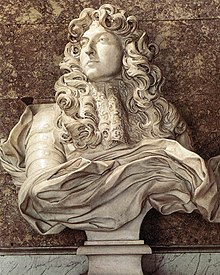Bust of Louis XIV (Bernini)
| Bust of Louis XIV | |
|---|---|
 |
|
| Artist | Gian Lorenzo Bernini |
| Year | 1665 |
| Catalogue | 70 |
| Type | Sculpture |
| Medium | Marble |
| Subject | Louis XIV of France |
| Dimensions | 80 cm (31 in) |
| Location | Palace of Versailles, Versailles |
| Coordinates: 48°48′15.8″N 2°7′23.3″E / 48.804389°N 2.123139°E | |
The Bust of Louis XIV is a marble portrait by the Italian artist Gian Lorenzo Bernini. It was created in the year 1665 during Bernini's visit to Paris. This sculptural portrait of Louis XIV of France has been called the "grandest piece of portraiture of the baroque age". The bust is on display at the Versailles Palace, in the Salon de Diane in the King's Grand Apartment.
Bernini had been invited to Paris as part of a larger diplomatic exchange between the Papacy and France. The ostensible reason for the visit was to create new designs for the Louvre Palace, but the young king Louis XIV had declared he also desired a portrait bust. Bernini’s designs for the Louvre did not go down well and were not acted upon; indeed their failure to be accepted was a reflection of the general antagonism between the Italian Bernini and certain members within the French court. However, the portrait bust, which depended upon a more personal relationship between the king and the artist, was completed and largely considered a great success.
The creation of the bust is incredibly well documented, thanks to efforts of the French diarist Paul Fréart de Chantelou, a steward at the court of Louis XIV, who befriended Bernini during his time in Paris.
The bust took just over three months to carve. Once potential blocks of marble had been selected, Bernini began by taking drawings (none of which survive) and small clay models of the king., However, it seems that once he had done this initial work, Bernini chose to work only during sittings with the king. His pupil, Giulio Cartari, began work on carving down the chosen block of marble (and would later do much of the drapery work), and then Bernini took over, taking forty days to complete the work. He had hoped to have twenty sittings with the king during the final carving process, but in fact there were thirteen of around one hour each.
Bernini's son and biographer, Domenico Bernini, noted the artistic arguments of his father as to why the King agreed to sit for such a length of time, explaining that the artist preferred to work from Truth (i.e. real life) rather than rely on the unnecessary imaginative extras that would creep into working from sketches. Equally, Bernini wanted to see the king, as he did many of this other sitters, not remaining immobile, but sitting and talking in such as way that Bernini could capture all his characteristics. Such an approach, with Bernini wishing to capture the figure in physical and psychological motion, was a common element of Bernini’s work: “mere resemblance is inadequate. One must express what goes on in the heads of heroes,” Bernini is recorded as saying. Bernini also observed the king in other locations - playing tennis, resting after lunch, or simply walking around court.
...
Wikipedia
